Product Content Syndication: Tools, Services & Strategy for Multichannel Growth
Ever felt like keeping your product info updated across Amazon, Walmart, Shopify, Instagram, and everywhere else is like playing whack-a-mole? The moment you fix one listing, another one appears with the wrong color, a missing image, or an outdated price. That’s where product content syndication swoops in to save the day — turning chaos into a smooth, automated flow that keeps your product data consistent everywhere your customers shop.
Today, brands need their product info to be not just accurate but polished across dozens of digital touchpoints, from Amazon and Target to social shopping ads. Each one has its own rules and quirks. Syndication makes sure your product data is compliant, consistent, and ready to go, no matter the platform.
What is product content syndication?
Without it, you’re stuck with slow, manual updates – the kind that lead to errors, mismatched listings, and frustrated shoppers.
That’s why syndication platforms are a game-changer. They come with prebuilt templates, mapping tools, and validation rules that make sure every product listing matches each retailer’s specific requirements — whether that’s including GTINs, adding localized descriptions, or tweaking URLs for SEO.
And it’s not just about sending data. The best tools also handle image optimization, add enrichment layers, and connect via APIs so your content updates instantly.
Fast, accurate syndication also speeds up onboarding with retailers and boosts your performance scorecards on marketplaces like Google Shopping and Walmart, meaning your products show up more often, in better positions.
Why Businesses Need Product Data Syndication
Here’s the catch: every single one of the sales channels has its own set of rules, from image sizes and naming conventions to taxonomy and content standards. And trust me, trying to manually manage that across even five or ten channels gets out of hand fast. One wrong format, one missing field, and boom — you’ve got delays, errors, or worse, unhappy customers.
That’s exactly why product content syndication matters so much. It takes that headache off your plate and gives you a way to scale your content updates without breaking a sweat.
A centralized syndication system enables teams to automate delivery, enrichment, and version control of content across every endpoint — ensuring consistency, accuracy, and marketplace compliance. It also supports faster time-to-market for product launches by removing manual bottlenecks in the publishing process.
For eCommerce businesses, syndication solves three critical problems at once:
- It removes redundancy and errors in content operations.
- It enables rich content distribution — including videos, interactive media, and enhanced brand pages.
- And it ensures channel mapping is handled automatically, translating internal product attributes into the logic required by each destination (e.g., Amazon, Google Shopping, Shopify, or regional marketplaces).
The importance of accurate content cannot be overstated: according to Salsify’s 2025 Consumer Research Report, 54% of shoppers abandoned a purchase due to inconsistent product information across different websites, and 53% left because titles or descriptions were incomplete or poorly written. This reveals how inconsistent or incomplete content directly drives significant revenue loss. Providing relevant information to consumers is essential for improving engagement and reducing abandonment.
Consumer trust can be enhanced through consistent and reliable product content across all sales channels, further reducing abandonment rates.
The result? Faster launches, higher conversions, and a more consistent brand experience across the digital shelf, with fewer resources.
How Product Content Syndication Works: End-to-End Process
To truly benefit from product content syndication, brands must understand the full process, from raw data to live product listings. It’s not just about pushing content to Amazon or eBay. It’s about transforming data into consistent, channel-optimized content across the digital shelf. Integrating content syndication with a PIM often cuts several steps out of complicated workflows, making the process more efficient. An automated process is key to efficient product content syndication, allowing brands to scale and maintain accuracy across multiple channels.
Here’s how product content syndication for web and marketplaces typically works:
- Data Ingestion & Centralization. Product data is pulled from various sources – ERP systems, PIM tools, DAMs, and spreadsheets. This raw input is centralized and prepared for structuring.
- Content Enrichment. Text, media, and attributes are refined. This includes marketing copy, optimized titles, feature bullets, images, and localized descriptions to create conversion-ready content.
- Taxonomy Mapping & Structuring. Products are categorized using internal logic, then mapped to retailer-specific taxonomies like Google Product Categories or Amazon nodes. This ensures compatibility and better search visibility.
- Validation & Compliance. Syndication platforms run rule checks to ensure all required fields — like GTINs, dimensions, and image sizes – meet marketplace standards. This prevents listing errors and feed rejections.
- Channel Distribution. Once validated, the system syndicates product content to various retail endpoints, such as eCommerce sites, social commerce tools, price comparison engines, and major marketplaces. This automated process ensures product data is distributed and synchronized across all relevant retail endpoints.
- Monitoring & Optimization. The system tracks KPIs such as feed health, data accuracy, and content approval rates. Any issues trigger alerts for rapid remediation.
This structured, repeatable pipeline is the engine behind modern product content syndication for web and eCommerce growth. It enables fast product launches, increases listing accuracy, and supports dynamic content updates at scale.
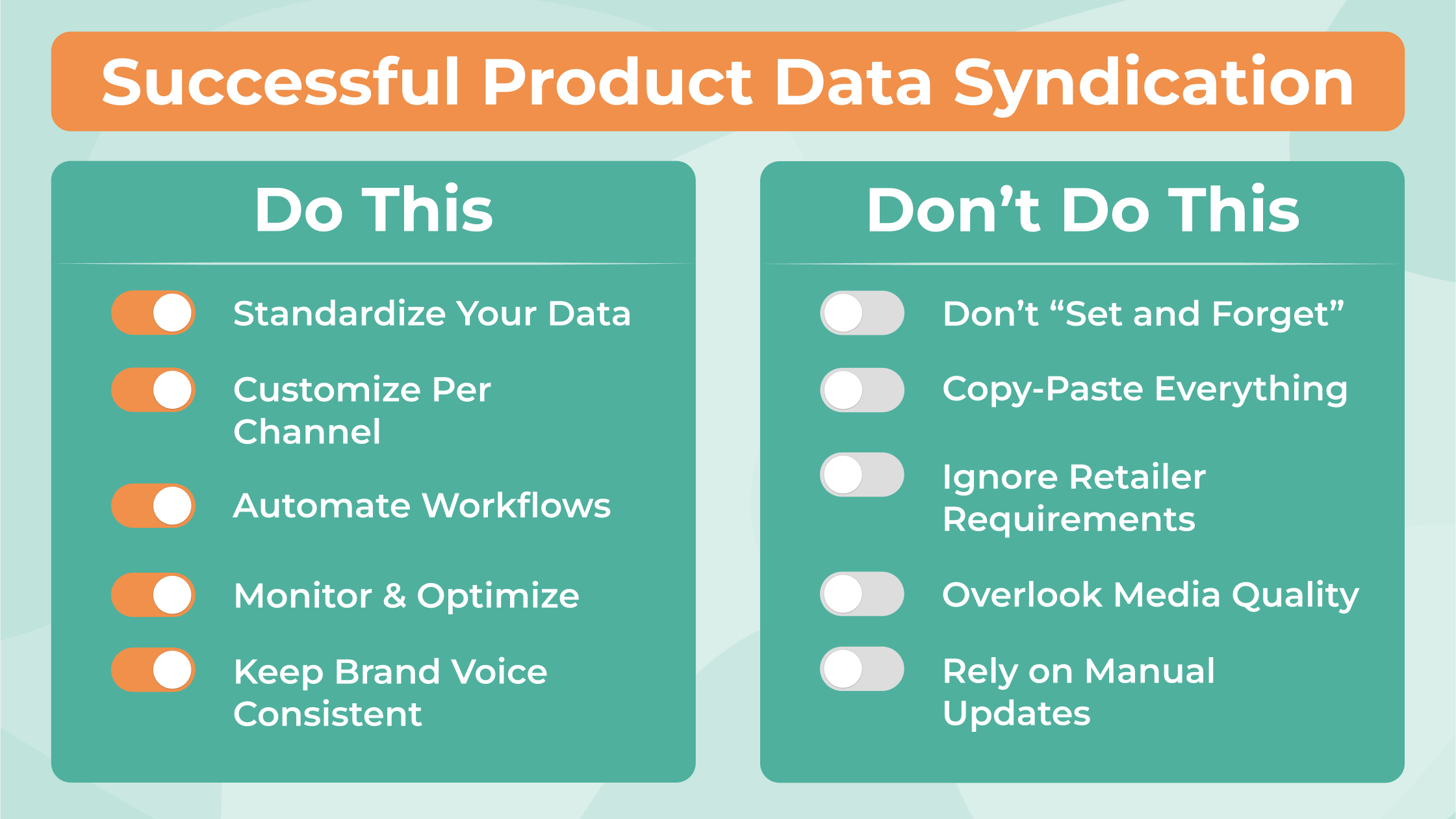
Product Content Syndication Services vs. Software vs. Platforms
As businesses mature in digital commerce, their need for streamlined product content syndication increases — but so does the complexity of choosing the right solution. The market offers a variety of options: from managed product content syndication services to self-service platforms and integrated syndication software within broader PIM ecosystems. It’s important to evaluate current syndication processes for potential improvements when choosing a solution, especially considering how internal teams collaborate and manage workflows.
Understanding the differences is key to choosing the right fit.
Product Content Syndication Services (Managed)
These are typically white-glove solutions provided by agencies or third-party providers. In a managed syndication model, the service provider handles everything — from data preparation and channel mapping to manual uploads and retailer coordination. Bulk editing capabilities are a useful feature to look for in syndication solutions, as they can streamline updates and ensure consistency across channels.
Best for:
- Small-to-mid businesses without in-house content teams.
- Brands launching in new markets that require onboarding support.
- One-off syndication campaigns or seasonal projects.
| Pros | Cons |
|
|
Syndication Software (Standalone)
Syndication software offers dedicated tools that businesses can integrate with their existing product content systems. These tools handle feed creation, transformation, and validation for a wide range of channels. Many solutions now support direct integrations with popular sales channels, allowing seamless data transfer between PIM systems and platforms like Shopify via API.
Best for:
- Mid-sized brands needing recurring content exports.
- Retailers managing hundreds of SKUs across multiple platforms.
| Pros | Cons |
|
|
Syndication Platforms (Enterprise-Grade)
Full-scale syndication platforms offer the most advanced and scalable solution. These platforms often include integrated PIM, DAM, translation management, and AI-assisted enrichment modules. They enable AI-powered syndication workflows — using logic engines, automation triggers, and dynamic channel-specific templates. Internal teams can collaborate more efficiently within these platforms, optimizing manual tasks and streamlining workflow management.
Best for:
- Enterprises managing thousands of SKUs across global markets.
- Teams requiring omnichannel presence with local customization.
- Businesses aiming to scale content operations long-term.
| Pros | Cons |
|
|
In recent years, the rise of enterprise product syndication tools — especially those powered by AI, has made it easier for brands to unify processes, shorten go-to-market timelines, and eliminate content inconsistencies across channels. Vendors should be evaluated based on their relationships with priority retailers to ensure seamless integration and compliance.
The best solution depends on your catalog size, channel diversity, and internal content maturity. For emerging businesses, product content syndication services may be the quickest path. But for scale, automation, and ROI, dedicated syndication platforms deliver the most impact.
Key Features to Look for in a Product Content Syndication Tool
Choosing the right product content syndication tool is essential for scaling eCommerce operations across multiple channels. With hundreds of platforms requiring unique content structures, the right system must go beyond simple feed generation — it must orchestrate intelligent, automated, and compliant syndication across the digital shelf.
Here are the must-have features for modern product content syndication software:
1. Automated Content Delivery & Channel Mapping
Look for a solution that supports automated content delivery to multiple endpoints, from Google Shopping to niche B2B marketplaces. These tools deliver content efficiently to a wide range of digital point of sale locations, ensuring your product data reaches retailers and marketplaces seamlessly. This includes built-in channel mapping logic that automatically transforms product attributes and taxonomy according to each retailer’s specifications.
For example, a tool like the Gepard PIM Solution offers robust integration layers that adapt your internal taxonomy to external formats — removing friction and human error in the publishing process.
2. Taxonomy & Attribute Normalization
Retailers often require specific attribute naming conventions, units of measure, and logic trees. Your tool must support taxonomy alignment — and ideally, offer automated catalog management via rule engines or templates. This ensures your categories, attributes, and values remain consistent across platforms. Learn more about Gepard’s Automated Catalog Management.
Every channel enforces different retailer data compliance standards. Your solution should include real-time validation to ensure listings meet mandatory field requirements, image specs, and value rules. This helps avoid listing rejections and ensures full market visibility from day one. A PIM solution ensures that the content is prepared correctly, while an FMS ensures it reaches those endpoints efficiently. Additionally, the ability to export product feeds and import and export product data across platforms like Shopify, WooCommerce, and Magento is essential for synchronizing product information and maintaining consistency.
4. Workflow Automation
A great product data syndication tool should automate approval flows, schedule content updates, and support dynamic enrichment. Features like auto-triggered updates when product data changes, or locale-specific fallback logic, are crucial for reducing manual oversight and speeding up go-to-market timelines.
5. Multilingual & Multiregional Support
If your business serves international markets, choose a system that allows localization for languages, currencies, taxonomies, and compliance metadata. This is vital for executing a consistent and scalable product content distribution strategy.
6. Performance Analytics & Feedback Loops
Syndication shouldn’t end at delivery. The best tools include dashboards that track listing errors, content health, product availability, and approval rates — feeding this data back into your optimization workflows.
As marketplaces grow more algorithmic and strict, relying on spreadsheets or legacy tools becomes unsustainable. Modern ecommerce businesses need product content syndication tools that combine automation, compliance, and intelligence — unlocking both scalability and performance.
Top 6 Product Content Syndication Tools & Platforms
Selecting the right product content syndication software is critical for delivering consistent, accurate, and channel-ready product data across a growing number of platforms. As brands expand into multichannel and global markets, the need for scalable, automated, and customizable syndication tools becomes even more pressing. Joining a syndication network can streamline content management, ensure data consistency, and maximize exposure by distributing your product feed across multiple sales channels. Taking advantage of demos can help businesses assess the capabilities of syndication solutions and make informed decisions.
Here’s a look at six leading product content syndication platforms, each offering unique features for different business needs:
1. Gepard Syndication

Gepard Syndication provides a flexible, automated platform for manufacturers, retailers, and brands looking to centralize and distribute product content across eCommerce, B2B, and retail channels. Gepard enables the generation and management of product feed files, product feed urls, and feed urls, simplifying the automated distribution of product feeds to multiple endpoints. It simplifies taxonomy mapping, validation rules, and content transformation with built-in AI logic and real-time channel updates.
Strengths:
- Automated taxonomy & format mapping
- Support for EPREL, ETIM, GDSN, and custom retailer specs
- Fast onboarding for supplier product data
Use Case Fit: B2B and B2C businesses requiring rapid multichannel scaling and high SKU volumes.
2. Syndigo
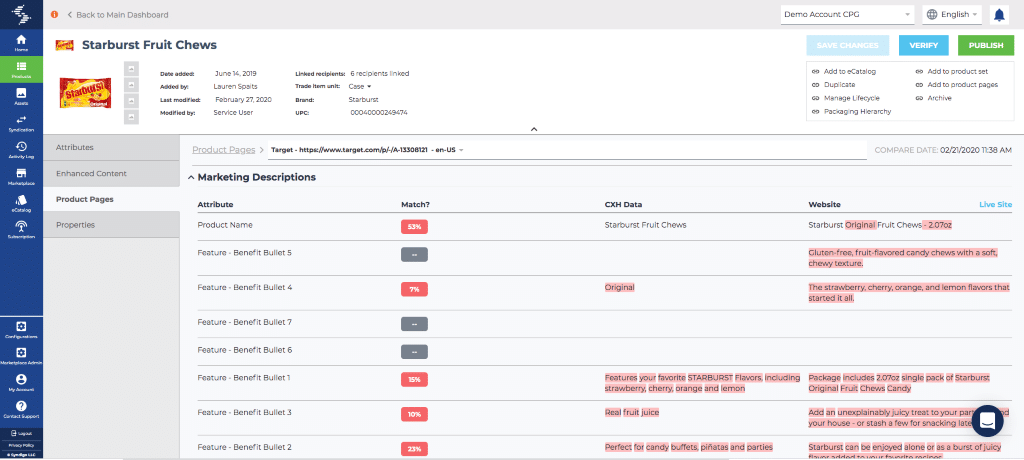
Syndigo offers one of the most comprehensive content distribution networks available. It integrates with global retailers and data pools, providing real-time content delivery across hundreds of endpoints. Syndigo generates and manages product feed files and product feed urls, enabling automated updates and distribution of product data to various channels, including comparison shopping engines. Known for its seamless GDSN support, Syndigo helps brands meet compliance standards in industries such as food, healthcare, and CPG. Its advanced analytics suite allows monitoring performance across channels.
Strengths:
- Deep retailer integration (including Walmart, Amazon, Target)
- GS1 GDSN and regulatory compliance
- Real-time validation and reporting tools
Use Case Fit: Large enterprises in regulated sectors seeking scale and compliance.
3. Salsify
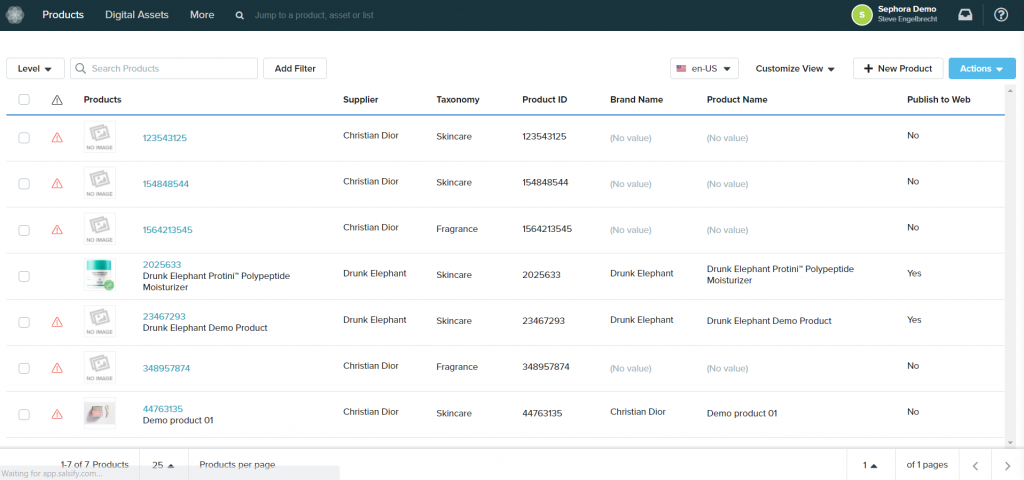
Salsify combines PIM, DAM, syndication, and digital shelf analytics in one platform. It excels in retailer-specific content readiness and enables teams to customize product data per channel using predefined templates and dynamic rules. Salsify supports the creation and management of product feed files and product feed urls, automating the syndication of product feeds to a wide range of sales channels and marketplaces. Its collaboration workflows make it ideal for large content teams and multi-brand portfolios.
Strengths:
- Advanced channel rule mapping
- Syndication to over 150 marketplaces
- Rich analytics dashboard for content health and performance
Use Case Fit: Mid-to-enterprise brands managing multiple marketplaces and internal content teams.
4. Catsy
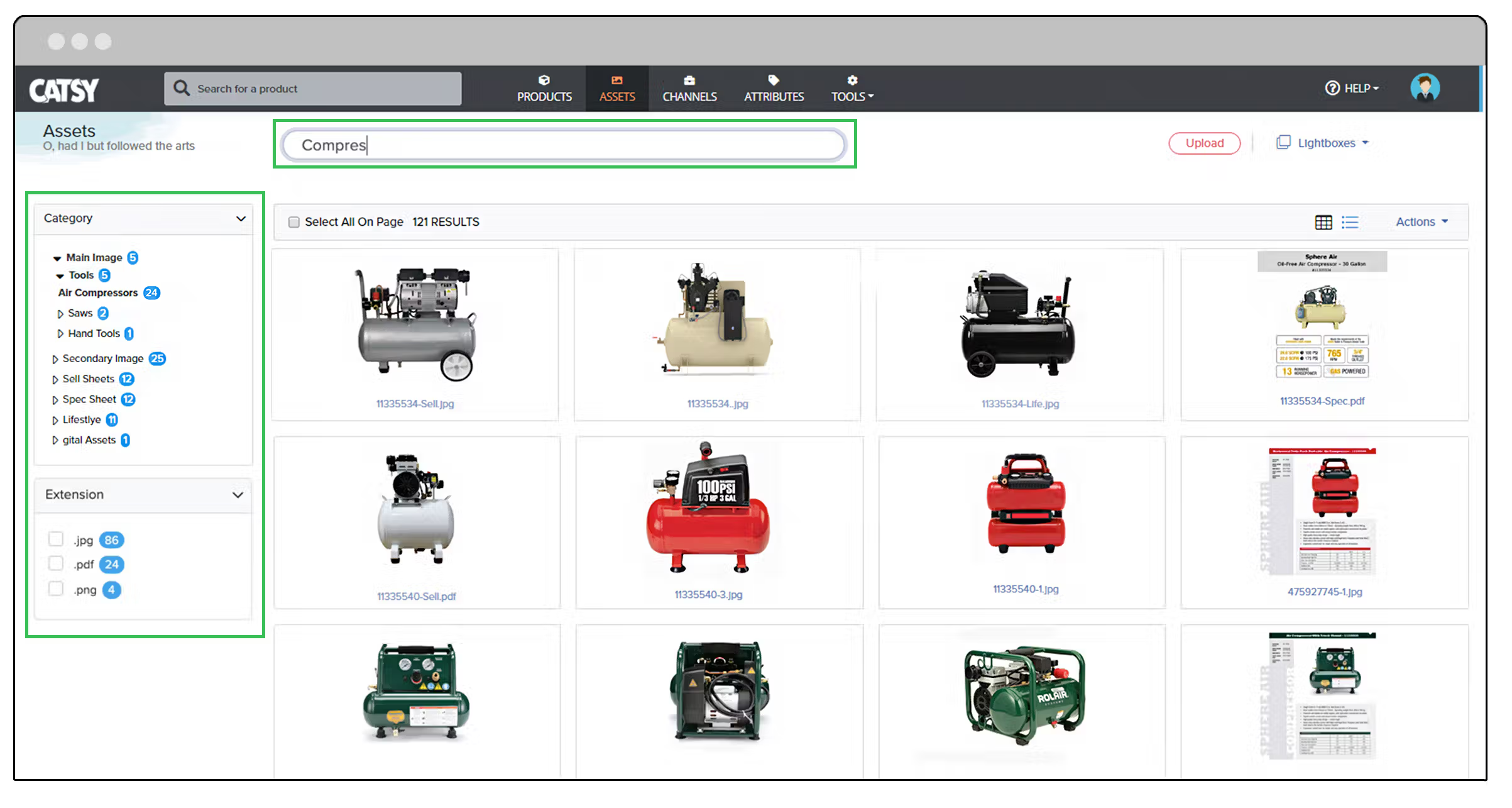
Catsy is a user-friendly product content syndication platform that blends PIM and DAM features to help small to mid-sized brands syndicate rich product content. Catsy supports the creation of product feed files and product feed urls, making it easy to distribute product feeds to eCommerce channels and comparison shopping engines like Shopify, BigCommerce, and Amazon. It offers intuitive UI, catalog builder tools, and syndication to eCommerce channels.
Strengths:
- Strong PIM & DAM integration
- Lightweight syndication to key D2C platforms
- Easy setup for smaller teams
Use Case Fit: D2C brands and SMBs needing fast, manageable syndication without complex setups.
5. Semarchy

Semarchy offers a flexible MDM platform that includes syndication capabilities for brands with complex product hierarchies and governance needs. It supports multiple data domains and advanced workflows for managing product content across decentralized systems. Semarchy enables the management of product feed files and product feed urls, supporting automated product feed distribution to various channels.
Strengths:
- Enterprise-grade data governance
- Customizable syndication connectors
- Designed for complex data ecosystems
Use Case Fit: Enterprises with multiple brands or business units needing high control over the data lifecycle.
6. Plytix

Plytix is a collaborative, cloud-based PIM with lightweight syndication features aimed at small teams. It offers channel-specific export templates, product sheets, and integration with CMS or eCommerce platforms. Plytix allows users to generate product feed files and product feed urls for automated syndication of product feeds to selected channels. Plytix also emphasizes collaborative content enrichment.
Strengths:
- Affordable for SMBs
- Easy-to-use syndication tools
- Integrated product sheets and digital catalogs
Use Case Fit: Small businesses or startups managing content across a few key marketplaces.
| Platform | Best For | Key Features | GDSN Support |
| Syndigo | Enterprise & Compliance | Real-time validation, deep retailer integration | Yes |
| Salsify | Brands w/ large content ops | Workflow automation, shelf analytics | Partial |
| Gepard | Scalable B2B/B2C syndication | Automated taxonomy, global standards support | Yes |
| Catsy | D2C & SMB brands | Simple setup, Shopify integration | No |
| Semarchy | Enterprise MDM/complex data | Governance, MDM, flexible connectors | Yes |
| Plytix | Startups & small teams | Collaboration, digital catalogs | No |
As the digital shelf becomes more crowded, choosing the right product content syndication tools ensures that your brand not only reaches the right audiences but does so with consistent, high-quality data. Whether you’re scaling globally, operating across multiple marketplaces, or managing suppliers, the right solution will provide the structure, automation, and adaptability needed to stay competitive.
Digital Asset Management in Product Content Syndication
Digital asset management (DAM) is a foundational element in successful product content syndication, especially for brands operating across multiple channels. A robust DAM system enables businesses to centralize, organize, and control all digital assets—such as product images, videos, how-to guides, and marketing documents—ensuring that every asset is easily accessible and ready for syndication.
Centralized digital asset management also streamlines collaboration among multiple teams, allowing marketing, product, and e-commerce departments to work from a single source of truth. This not only improves brand consistency but also enhances customer engagement by delivering high-quality, on-brand visuals and rich media wherever customers expect to find them.
Ultimately, leveraging DAM within your product content syndication process enables businesses to scale their content operations, maintain control over brand representation, and deliver a seamless experience across all digital touchpoints.
Data Feeds and Feed Management
Data feeds are the backbone of effective product content syndication, enabling businesses to export product information in a standardized, structured format to a wide range of sales channels. Feed management systems play a critical role in this process by helping companies create, customize, and optimize product feeds for each channel’s unique requirements.
A modern feed management system automates the syndication process, ensuring that product listings are always accurate, up-to-date, and compliant with retailer requirements. Whether you’re syndicating to Google Shopping, Amazon, or niche marketplaces, feed management tools allow you to tailor product feeds, adjusting attributes, images, and pricing, to meet the specific needs of each platform.
By reducing manual work and automating updates, feed management systems help businesses maintain high-quality product content across various sales channels. They also provide analytics and monitoring features, so you can track feed performance, identify errors, and quickly resolve issues before they impact your product listings.
Incorporating data feeds and feed management into your content syndication strategy not only streamlines operations but also ensures your products are discoverable and competitive across the digital shelf.
Brand Consistency and Compliance
Maintaining brand consistency and compliance is essential for building trust and loyalty in today’s multichannel e-commerce environment. A product content syndication solution provides the centralized control needed to ensure that product descriptions, images, and other content remain uniform across all sales channels.
Automating the syndication process with a dedicated syndication solution helps businesses meet retailer requirements and avoid costly errors, such as incorrect product information or missing attributes. This not only protects your brand reputation but also reduces the risk of fines, delisting, or lost sales due to non-compliance.
A content syndication solution enables businesses to monitor and enforce brand guidelines, ensuring that every product listing reflects the correct messaging, imagery, and pricing. By delivering consistent, high-quality product content, companies can enhance customer engagement, drive conversions, and strengthen their position across multiple sales channels.
In summary, investing in a robust product content syndication solution is key to achieving both brand consistency and compliance, supporting long-term growth and customer satisfaction.
B2B Product Content Syndication Use-Cases
In B2B commerce, content accuracy isn’t optional — it’s mandatory. Unlike B2C, where presentation drives sales, B2B buyers demand precision, compliance, and system-ready data. That’s why b2b product content syndication is critical for manufacturers and distributors managing complex catalogs across partner networks.
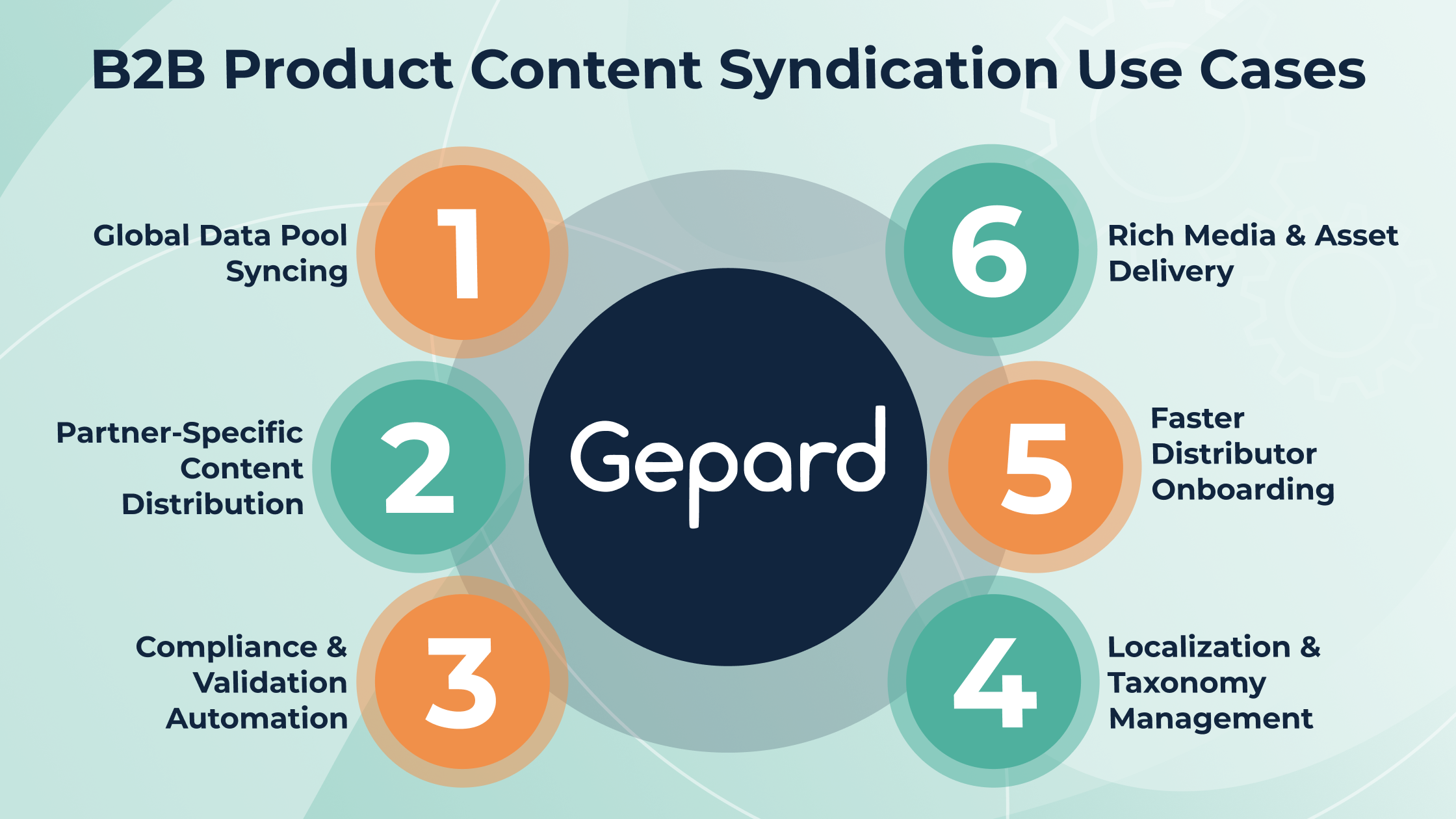
Take an industrial supplier managing thousands of SKUs. Product specs must align with frameworks like GS1 GDSN, ETIM, or customer-specific templates. Here, web product content syndication ensures each channel receives data in the exact format and structure it requires. Meeting each retailer’s requirements for data templates and compliance is essential for successful syndication.
A key use-case involves syncing industrial catalogs with global data pools like GS1 GDSN. Syndication tools automate the mapping of product attributes, validate compliance, and push updates in real-time — reducing errors and manual tasks.
Another scenario: distributing content to B2B partners that operate their own ecommerce stores or ERPs. Platforms like Gepard PIM Solution allow channel-specific exports with conditional rules, ensuring each partner gets tailored, compliant product data without delay. It is also crucial to provide retail partners with enriched product media to ensure consistent product presentation across all channels.
For onboarding new distributors, pre-configured templates eliminate repetitive work. A centralized syndication engine simplifies localization, taxonomy mapping, and version control — keeping content consistent across borders and categories.
As digital supply chains scale, b2b product content syndication becomes a growth enabler. It drives faster partner onboarding, ensures regulatory alignment, and builds trust in the brand’s digital infrastructure.
In short, whether you’re distributing to procurement platforms, industrial marketplaces, or regional dealers, smart syndication reduces friction and increases operational efficiency — making your B2B strategy future-proof.
Implementation Roadmap: From Pilot to Scale
Launching product content syndication at scale requires a phased, measurable approach. It begins with clear KPI definition: track time-to-market, product data accuracy, and content completeness per channel. These indicators help validate early-stage success and align business goals with syndication outcomes. Aligning marketing efforts with your syndication strategy is crucial to ensure that content distribution supports broader business objectives and maximizes impact across all channels.
In the pilot phase, select a manageable product segment and 1–2 core channels—typically your main ecommerce store and a marketplace like Amazon. This allows for testing feed structure, attribute mapping, and real-time updates without overloading systems.
Next comes internal stakeholder alignment. Product managers define the taxonomy logic; marketing ensures brand voice consistency; IT and data teams handle PIM connectivity and automation flows. Clear roles reduce friction and accelerate time-to-deploy.
A successful roadmap includes:
- Phase 1: Pilot — Test one syndication flow end-to-end with limited SKUs and 1 channel. Collect performance data.
- Phase 2: Iterate & Expand — Refine attribute sets, improve error handling, and introduce multi-language and regional feeds.
- Phase 3: Scale — Automate updates, onboard new channels, and enforce content governance policies.
Throughout the rollout, maintain feedback loops with channel partners and category managers. Their insights improve taxonomy, formatting, and compliance alignment.
By approaching implementation as a strategic process, rather than a one-time integration, brands create resilient syndication workflows ready to support digital growth at any scale.
Best Practices for Product Content Syndication
Nailing product content syndication doesn’t have to be complicated, but it does take a smart approach. Here’s how to make it work without losing your mind:
- Start with killer product content. Make sure your descriptions, specs, and images are detailed, accurate, and customer-friendly. Retailers love clean, complete data, and so do shoppers.
- Customize for each channel. Amazon, Walmart, Google Shopping… they all have their own rules. Tweak attributes, image sizes, and descriptions so they look great everywhere.
- Automate as much as possible. Use a solid syndication platform and connect it to your e-commerce and DAM systems. The less manual copy-pasting you do, the fewer mistakes you’ll have to fix later.
- Keep an eye on performance. Check your feed health and marketplace scorecards regularly. Use the analytics from your syndication tool to spot gaps and improve listings over time.
- Stay consistent, stay compliant. Consistency builds trust. Make sure your brand voice, product data, and compliance boxes are all checked across every channel.
Follow these steps and you’ll have cleaner listings, less manual work, and a stronger presence across all your sales channels.
Product Content Syndication & Marketing Alignment
Marketing teams and content syndication workflows must work in lockstep to deliver cohesive, brand-aligned experiences across all customer touchpoints. This alignment is particularly critical when dealing with rich media (videos, 3D renders, comparison charts) that elevate engagement and differentiate listings across retail channels. Including how-to videos as part of a comprehensive content strategy further enhances customer experience and builds trust by helping consumers make informed purchasing decisions.
Performance analytics help close the loop. Syndication platforms with built-in reporting allow marketers to track impressions, conversions, and channel-specific engagement. They reveal which content types drive results (e.g., lifestyle imagery vs. technical diagrams) and where enrichment is still needed.
By integrating syndication into campaign planning, brands ensure content is not only distributed but also optimized for discovery, action, and relevance, reinforcing the role of product content syndication software as a growth enabler, not just a data pipe.
Future Trends: AI, PIM-CDP Convergence & Retail Media
The future of product content syndication will be shaped by intelligent automation and tighter tech integrations.
- We’re already seeing AI-powered predictive mapping tools emerge — capable of auto-classifying SKUs, correcting attribute gaps, and suggesting optimal product positioning across sales channels based on historical engagement and channel performance.
- Meanwhile, PIM systems are converging with CDPs (Customer Data Platforms), enabling hyper-personalized content delivery. Think dynamic product descriptions, image variants, or banners generated in real time based on shopper segments — all syndicated from a single source of truth.
- Retail Media is another rising frontier. As retailers monetize their digital shelf, brands must ensure their syndicated content supports sponsored placements, advanced targeting, and channel-native formats.
In short, product content syndication is evolving from an operational necessity to a core marketing strategy — one that blends automation, personalization, and data intelligence for maximum impact.
Conclusion: Scale Your Growth with Product Content Syndication
In an omnichannel environment, accurate and optimized product data is more than a backend task — it’s a competitive advantage. From onboarding global partners to powering retail media, product content syndication ensures that your content is consistent, complete, and conversion-ready across every digital shelf.
By adopting the right product content syndication services, brands unlock operational efficiency, boost SEO, and improve customer experience, all while scaling faster into new markets and platforms. But true success comes from a unified strategy: one that aligns marketing goals, data governance, and automation workflows.
As future trends like AI-based mapping and PIM-CDP convergence reshape the landscape, businesses that invest early in structured syndication will be positioned to lead, not follow.
Ready to optimize your multichannel strategy?
Explore how Gepard’s Product Content Syndication platform helps brands streamline delivery, enhance data quality, and scale globally — all from a single source of truth.



